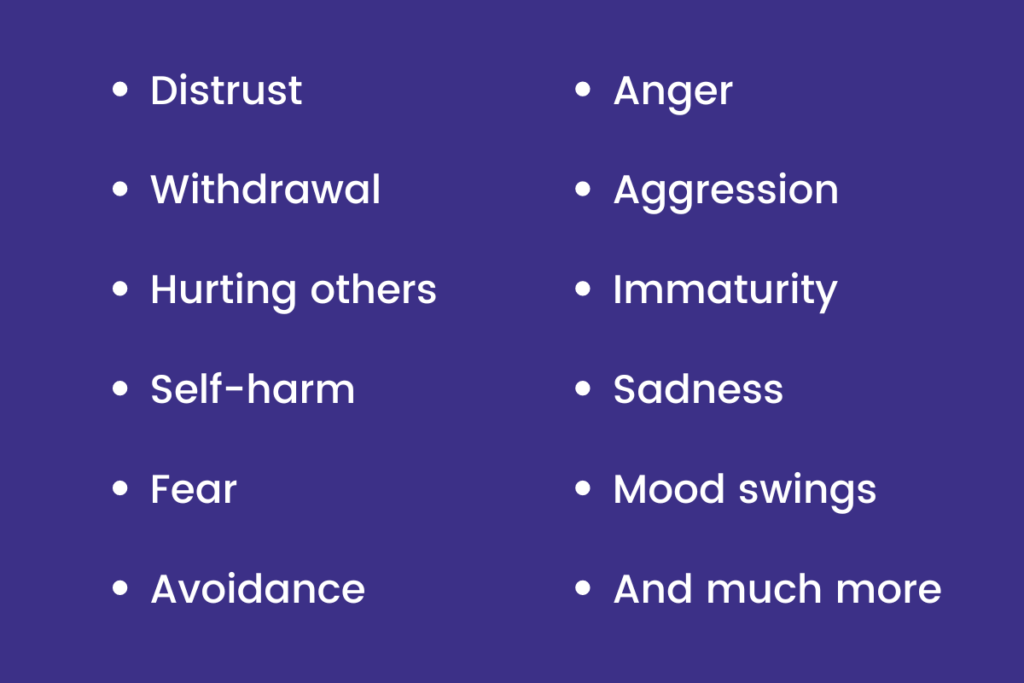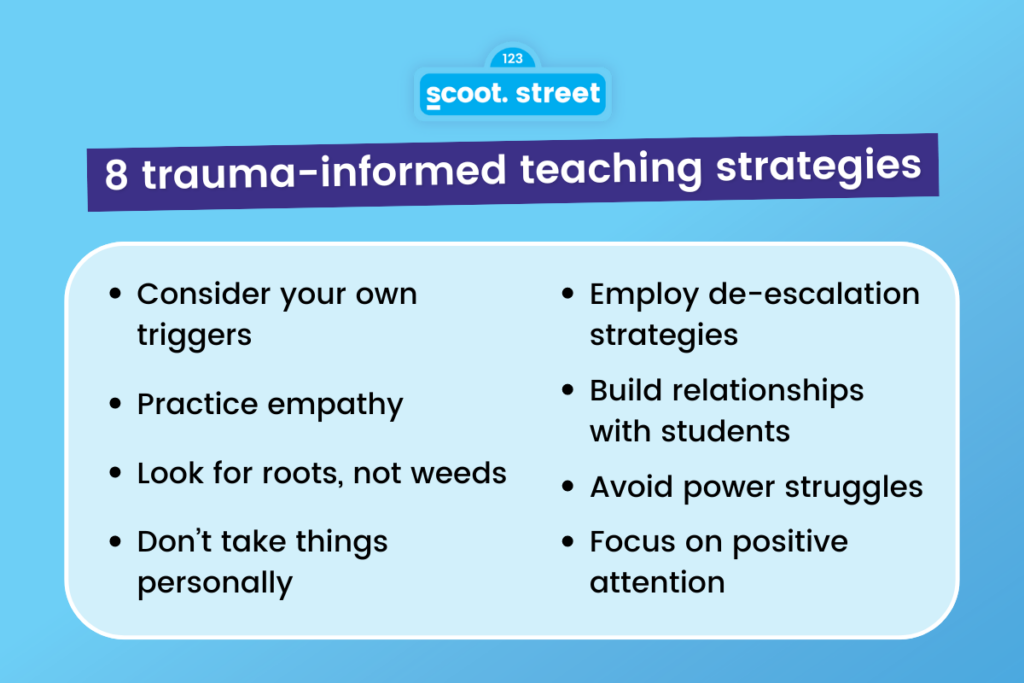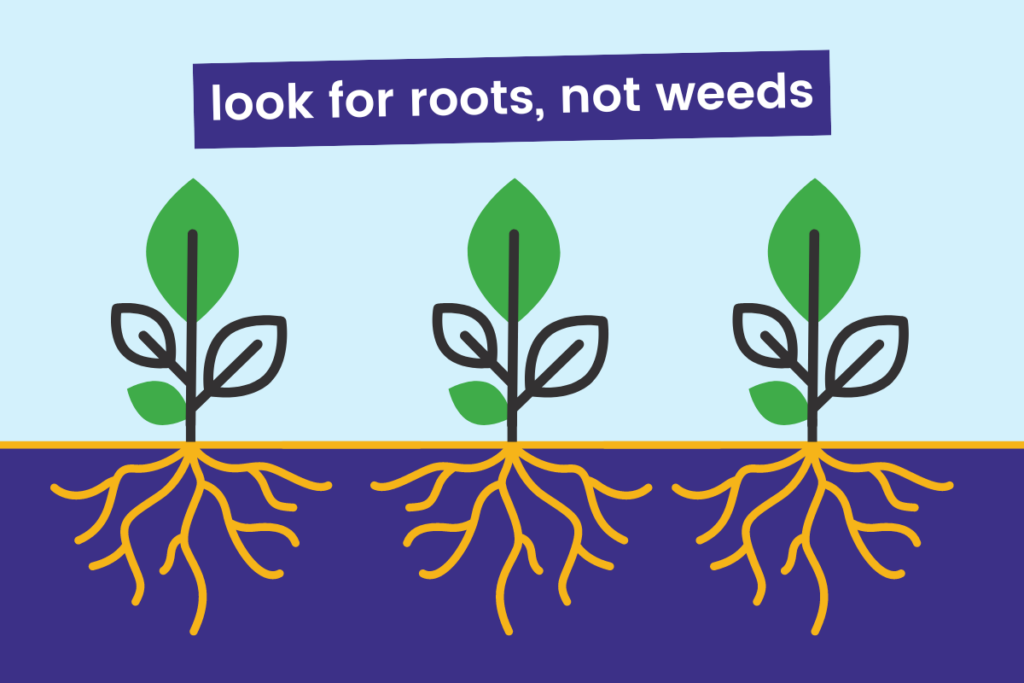Search
Get started
Log into your referral dashboard
Students affected by trauma are more likely to take longer to complete tasks and fall behind in class.
At least 60% of students that enter our classrooms daily have been impacted by adverse childhood experiences. Yet, the main goal at school is still to teach students content and life skills.
So how can educators show our students the care and support they need in order to help them learn?
Trauma-informed teaching is an approach that considers how trauma can impact learning and behavior. As educators think about what student behavior may be telling them, they can respond in more thoughtful ways.
Our blog will dive into 8 strategies and mindsets to help you reframe your interactions with students.
Table of contents
What does trauma look like in students?
8 trauma-informed teaching strategies
- Consider your own triggers
- Practice empathy
- Don’t take things personally
- Look for roots, not weeds
- Employ de-escalation strategies
- Avoid power struggles: Give students a choice
- Build relationships with students
- Focus on positive attention
What is trauma?

Trauma can be defined as a physiological and emotional response to any deeply distressing or disturbing event or experience.
Child trauma occurs more often than you think. More than two thirds of children report at least 1 traumatic event by age 16. In 2019, about 1 in 5 high school students reported being bullied on school property in the last year.
Students can experience trauma through ongoing exposure, throughout their early development. Potentially traumatic events include:
- Witnessing or experiencing abuse
- Neglect
- Homelessness
- Domestic violence
- Community disasters
- Refugee or war experiences
- Sudden or violent loss of a loved one
What does trauma look like in students?
Students who’ve gone through trauma may hide their pain or mask it in another response. Trauma responses in students can look like:

Knowing how trauma affects students prepares us to respond appropriately. Students dealing with trauma are especially prone to:
- Difficulty in self-regulation
- Negative thinking
- Being on high alert
- Difficulty trusting adults
- Inappropriate social interactions
Remember, all behavior is trying to communicate something. Kids (and adults) don’t leave their trauma at the door once they enter the classroom. That “invisible backpack” travels with us everywhere, even to school, and every student will express the weight of what’s inside that backpack differently.
Important note: A trauma-informed teaching approach assumes that you may never know what your students are carrying in their “invisible backpack,” but it’s your job to acknowledge it and approach their behavior and learning with this in mind.
8 trauma-informed teaching strategies

We won’t always know if or how our students are experiencing trauma, yet we still expect students to come into the classroom focused and ready to learn.
Here are a few strategies we believe educators can use to be more supportive of students dealing with trauma.
1. Consider your own triggers
Teachers are humans. We all have triggers or particular student behaviors that tend to activate our own natural responses. We can–and must–build awareness about our own triggers to ensure our response to students is empathetic, supportive, and kind.
To build awareness, practice self-reflection. Notice when you feel strongly offended or upset toward a certain kind of behavior. Consider why that is triggering for you. Reflect on your teaching experience growing up, your life experiences and relationships, or your cultural identity. Lastly, consider what you can do to mitigate these triggers.
2. Practice empathy

You don’t have to have experienced trauma yourself to be empathetic to someone who has. Acknowledge a student’s big feeling. Help them identify it by asking them how they feel or naming the feeling you see the student expressing. It’s okay if you’re wrong, they’ll probably correct you.
If you don’t feel equipped to talk with your students about it or if they request to speak to another staff member (counselor, dean, etc.), give them a hall pass and allow them to do so while taking note of the situation.
3. Don’t take things personally
Our Scoot sub Lakiesha Smith says, “They can come in with a lot of trauma. A lot of their issues are not personal. So, sometimes, there’s a verbal exchange with inappropriate language and profanity involved, and you’re on the other end of it. You’re like, ‘Why me?’ and it’s not really about you. It could be about something that happened at home, the night before, or something that’s been going on for weeks now.”
Keep in mind that 99% of the time it’s not about you. Remember the “invisible backpack” of other stressors that could be weighing down students.
4. Look for roots, not weeds

If all behavior is communication, what is your student’s behavior communicating? Take time to privately ask the student and listen to what they have to say.
Student behaviors are like weeds. If we just look at the surface, we often miss the root cause. Always look for potential root causes.
Smith says it better than us:
“[Try] to understand where the issues derive from. […] They are going through something very personal that’s bothering them.”
5. Employ de-escalation strategies
It’s important to maintain these classroom management techniques to keep a calm, orderly classroom:
- Stay calm: Keep a calm, neutral voice to keep situations from escalating and help model for students how to de-escalate their emotions.
- Give students roles: Empower students by entrusting them tasks. They’ll feel positive about their contributions.
As a last resort, you can always call the front office for help in extreme cases after you’ve exhausted all other strategies.
6. Avoid power struggles: Give students a choice

It’s easy for an educator to demand obedience and order. But students are much more willing to trust educators who respect them. When misbehavior happens, give students a choice, give them space to reflect, and move on. Don’t try to win or look tough.
Instead of confronting a student in front of everyone, try private, nonverbal redirection. Give students extended time to comply with directions, rather than demanding immediate compliance.
7. Build relationships with students

Show genuine interest in students’ lives outside academics by asking about their interests and experiences. If you have extended opportunities to interact with them, try the “two by ten” rule. Talk to a student for two minutes a day for 10 days in a row about topics unrelated to academics or behavior.
Check out our other blog for more tips on how to build relationships with students.
8. Give positive attention

Students who experience chronic neglect and negative thinking may act out more because they realize negative attention is fast, predictable, and efficient.
Positive attention, on the other hand, should also be just as fast and frequently shown to kids. This includes praising good behavior, as well as surprising kids with “random acts of kindness.” Make sure to express warmth that isn’t necessarily earned.
Additional resources
While these strategies help foster a trauma-informed teaching approach, they aren’t exhaustive. Check out these websites to further your understanding in trauma-informed teaching and how trauma impacts children:
- SAMHSA – National Child Traumatic Stress Initiative
- Child Mind Institute – Trauma & Grief
- ASCD – Trauma-Informed Teaching Strategies
Wrap-up
All kids will benefit from a trauma-informed teaching approach. We don’t need to single out the kids who have explicitly been impacted by trauma and use these strategies only on them.
If you’re looking for more in-depth training on this topic and much more on your way to becoming a well-rounded guest educator, consider applying to Scoot Education!
We’re an educational staffing company dedicated to creating exceptional experiences in education. This means whether you’re a sub, paraprofessional, or a teacher aide, you get access to:
- Training resources to sharpen your skills in classroom management, lesson internalization, and more
- A personal Education Consultant who understands your day-to-day and works closely with you to fit your needs
- More job opportunities, more fun!






